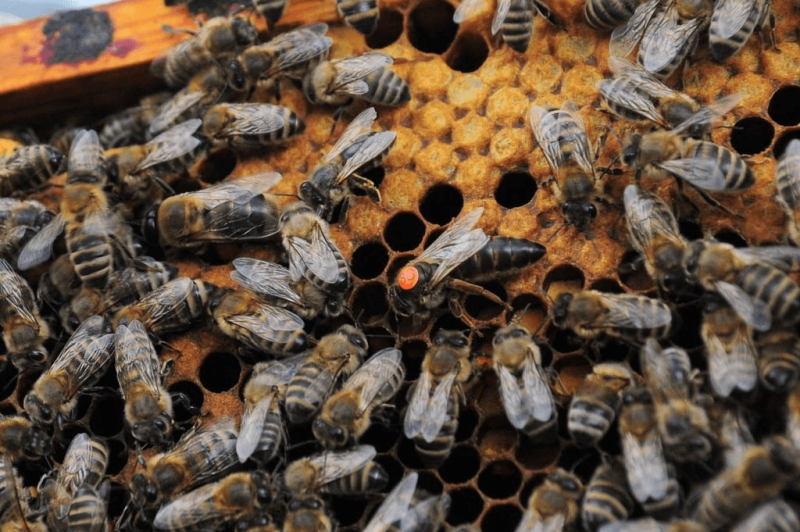The study, which was recently published in the Proceedings of the Royal Society B, compared rates and severity of DWV in wild honey bees from a forest outside Ithaca, New York, to bees from managed apiaries in New York and Pennsylvania. The researchers found that while infection rates were similar across all groups, a virus genotype — or variant of a virus — found in the wild honey bee population resulted in milder infections than the virus found in the managed apiaries.
This suggests that similar to certain variants of human viruses leading to less severe infections, there could also be less virulent strains of DWV circulating among honey bee populations, according to Allyson Ray, a postdoctoral scholar at Vanderbilt University who led the study while a College of Agricultural Sciences graduate student at Penn State in the Molecular, Cellular, and Integrative Biosciences Graduate Program.
Ray added that in the future, the findings may be helpful in how scientists and beekeepers monitor and take care of bees.
“Learning how different virus genotypes could result in more or less severe infections could help us better understand infection dynamics in managed bee colonies,” she said. “If we know certain variants have the potential to cause more harm, that could be helpful for bee care as well as improving our understanding of this virus’s epidemiology.”
Christina Grozinger, Publius Vergilius Maro Professor of Entomology, director of the Center for Pollinator Research at Penn State and co-author on the study, said the work was an opportunity to examine virus dynamics in different types of bee colonies.
“Most research on honey bee-virus interactions focus on how bees respond to viruses and how we might be able to breed bees to become more resistant to the viruses,” Grozinger said. “However, disease ecology theory predicts that in areas where viruses cannot spread as rapidly to new hosts, the viruses might evolve to be less damaging to their hosts, giving the viruses more time to spread to new hosts. We had a perfect opportunity to test this theory using the wild honey bees found in the Arnot Forest in New York.”
Two of the biggest disease threats for honey bees, according to the researchers, are DWV and the tiny parasite that spreads it: the Varroa destructor mite. When mites infest a colony, they inflict damage both by living and feeding on bees directly and also by spreading DWV. The virus is most harmful when it infects bee pupae, which then grow up to have several deformations including twisted wings and often die shortly after reaching adulthood.
In apiaries, entire colonies can be wiped out by mite infestation and the associated viral infections within two to three years without proper human intervention. Wild colonies without human care, the researchers added, can be particularly vulnerable.
Despite this, scientists have identified colonies around the globe in recent years that have managed to recover and bounce back from mite infestation, including wild colonies in the Arnot Forest outside Ithaca. This population of bees has been studied for years by Tom Seeley, an emeritus professor at Cornell University and a co-author of this study. The researchers wanted to explore what might be contributing to these particular bees having better outcomes with the mites and associated DWV.
“Previous studies found that the honey bees from the Arnot Forest still had mites and were not significantly more resistant to mites than bees from managed populations,” Ray said. “So, we hypothesized that rather than the bees being more resistant to the mites, the virus may have evolved to be less virulent and cause milder infections.”
Grozinger noted that in managed apiaries, honey bee colonies are often placed very close together, and the bees can transmit viruses by drifting into each other’s colonies or by foraging on the same flowers.
“In the Arnot Forest, the wild bee colonies are spread farther apart, and so there should be less opportunities for bees to come in contact and spread the virus,” she said. “So, highly virulent viruses would kill their hosts too quickly to be spread, and milder viruses would persist in this population.”
To analyze what may be causing the bees in the Arnot Forest to be more resilient to disease, the researchers collected honey bees from 13 sites across the Arnot Forest, nearby apiaries in New York and in central Pennsylvania. They then analyzed infection rates across the three groups, extracted any virus present in the bees and sequenced the virus genomes.
Finally, they experimentally infected bees from two colonies in central Pennsylvania with strains of the virus found in the Arnot Forest and the managed apiaries.
The researchers found that there was no difference in the amount of virus present among the wild bees and the managed bees in both New York and Pennsylvania, with an approximate 40% to 57% infection rate across the three groups. Viral loads — or the amount of virus in each bee —were also similar across groups.
However, when the researchers compared how the Pennsylvania bees did after being infected with the different virus strains, they found that virus genotypes from the Arnot Forest resulted in milder infections and better survival compared to the viruses from the managed colonies.
“At very low doses, we saw survival rates with this virus similar to controls,” Ray said. “This doesn’t make it an absolutely avirulent infection, but it does show that broadly, there are differences in infection based on the viral genotype the bees are infected with.”
The researchers said that in the future, more studies and assessments of the virus within the Arnot Forest could help them better understand the selection pressure that is leading to the virus’s evolution.































